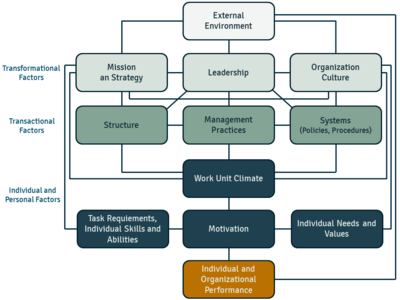Burke-Litwin model
| Burke-Litwin model |
|---|
| See also |
Burke Litwin model – helps to assess what are the effects of internal and external factors on the performance of the organization. It provides a framework on environmental and organizational success and the impact of such framework on the performance of company. The model describes a relationship between what can be achieved in real-life scenario and what has been achieved thorough research and theory (S. Thakur 2013). Undertaking organizational phenomena may cause many complications and this model classifies important organizational dimensions that help to detect the problem (T. Chawane, L. Van Vuuren, G. Roodt 2003, p. 62–76).
There are various reasons why the change occurs within an organization and Burke-Litwin model of organizational change and performance helps to understand and recognize what are the drivers and the implications of particular change. In the model, change drivers are presented in descending order in accordance to their importance. Such arrangement of the model explains how the factors affect each other, meaning that the change in one will impact the others.
12 elements of Burke-Litwin model
Burke and Litwin distinguished 12 elements that are important for organizational success:
- External Environment
- Mission and Strategy
- Leadership
- Organizational Culture
- Organizational Structure
- Systems and policies
- Management Practices
- Work Climate
- Task requirement
- Individual Values and Needs
- Motivation
- Individual and Overall Performance
Burke and Litwin claim that environmental element is an essential change driver. Such elements of organizational success like: leadership, strategy and organizational culture are triggered by external factors in the organization. The external environment explains competition, markets, economy and legislation which all have effects on the operation of any organization; therefore, it is reasonable to study such factors and their effects on the team.
The mission and strategy dimension gives the reason for the company's existence. This element explains how the organization achieves its objectives. It is high in the hierarchy as it is considered to be the foundation of any company. Changes in strategy must be clear and the roles of team members should be explained to them.
Leadership dimension highlights the behavior of senior members in a company and the effects of this behavior on the organization. The acceptability of the change depends mostly on top executives of the organization.
The organization culture gives the insights on how processes and work are performed in the company. Those are behaviors, values and believes that are ultimate for the organization.
Structure is about communication, decision-making, responsibility, authority and control between people in the workplace.
Work climate focuses on workers’ opinions about their work environment and about their colleagues which has the influence on the satisfaction level in the workplace.
Task requirements and Individual needs and values stand for understanding of the job and its requirements in order to fulfill the demands effectively. Those dimensions help to evaluate each employee according to their positions.
Employee motivation is considered to be significant for organizational goals. By identifying employees’ motivation, employers can better understand them and required efforts can be made to maintain the satisfaction in the workplace, so that the organizational goals are achieved.
Finally, Individual and Overall performance relates to the performance on the individual and organizational level in such areas as efficiency, quality, budget productivity and customer satisfaction. (W. W. Burke, G. H. Litwin 1992)
References
- Burke, W. W., & Litwin, G. H. (1992). A causal model of organizational performance and change. Journal of management, 18(3), 523-545.
- Chawane T., Van Vuuren L. & Roodt G. (2003). Personal change as a key determinant of the outcomes of organizational transformation interventions. SA Journal of Human Resource Management, 1(3), 62–76
- Martins, N., & Coetzee, M. (2009). Applying the Burke-Litwin model as a diagnostic framework for assessing organisational effectiveness. SA Journal of Human Resource Management, 7(1), 1-13.
- Thakur, S. (2013). Explaining the Burke-Litwin Change Model. Retrieved 2, 2017.
Author: Katarzyna Mamak
